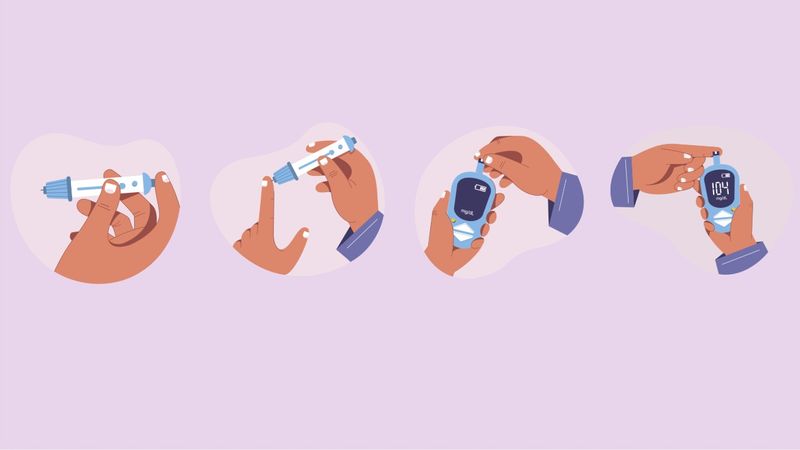

Our Review Process
Our articles undergo extensive medical review by board-certified practitioners to confirm that all factual inferences with respect to medical conditions, symptoms, treatments, and protocols are legitimate, canonical, and adhere to current guidelines and the latest discoveries. Read more.
Our Editorial Team
Shifa Fatima, MSc.
Author
Dr. Apoorva T, MHM.
MEDICAL ADVISOR
How To Use A Glucometer To Check Blood Sugar

Dealing with the news that you have either prediabetes or Type 2 diabetes is understandably not the best news. But then, one has to chin up and face the situation, right? The first prerequisite is a positive attitude! There's nothing to worry about. Diabetes is reversible in many cases, and in the rest, it is possible to control it effectively. Also know about pp blood sugar
Table of Contents
What is a Glucometer?
It's a simple medical device that you can use to measure your blood glucose level in the comfort of your home, without bothersome lab visits. You can keep a check to see that your glucose levels are neither too high nor too low. Know about diabetes treatment in pregnancy.
Types of Glucose Meters
Glucometers can be of different types. Each is known to have its own advantage and is made to make the life of a person with diabetes easier. Regular and timely blood sugar testing with a glucometer at home is something that most people with diabetes need to learn. This is what will eventually help them manage to keep their glucose levels optimal. With the advancement and innovation in technology, several types of glucometers are now available in the market.
- Non-invasive glucometers – This is a device that allows the monitoring of blood sugar levels without the need to draw blood or prick a particular puncture site. This can be done with the help of certain methods like – electrochemical methods, microwave methods, etc. They use a mechanism that checks the correlation between bio-fluids and blood glucose levels. Since there is a considerable amount of blood glucose in the bio-fluids it can help calculate the sugar levels in the body upon the calibration of the device.
- Continuous glucose monitor – In some cases wherein the blood sugar levels are very erratic, the person would need a glucose monitoring system that can help detect the normal blood sugar level glucometer readings or any abnormal ones too. This can be done with the help of a CGM machine. For type 1 and type 2 diabetes, this device can be inserted into the arms and a small electrode penetrates the skin and is held in place with the help of an adhesive. The transmitter attached to the electrode sends the blood sugar readings to the sensor.
Invasive testing – If you are learning how to use a glucometer to check blood sugar, you will be taught the most commonly used system – a machine with testing strips. This is the most popular and commonly used glucometer in the market. They are simple to use, easy to carry and give accurate results. Also know about glucometer price.
What are the Uses of a Glucometer?
If you have diabetes, you must use this sugar testing machine to control your condition better. Some of the top uses of a glucometer include:
- Checking whether the blood sugar levels are under control, high, or low
- Assessing how your body is responding to a particular diabetes treatment
- Observing blood glucose levels during stress or after heavy physical activities like exercise
- Understanding whether and to what degree lifestyle changes, including exercise and diet, are influencing your diabetes condition
- Recognizing blood glucose level patterns to determine the best future course of action

What Kind of People Should Use a Glucometer?
The use of glucometer is a must for people diagnosed with Type 1 diabetes, gestational diabetes, and Type 2 diabetes. It is an essential part of diabetes treatment, since regular tracking of glucose levels will help:
- Identify patterns of blood sugar spikes and crash after a particular activity
- Regulate the effects of therapies or anti-diabetic drugs
- Observe the blood sugar level’s responsiveness after taking a particular medication dose, exercising, or during times of stress
- Evaluate how a person can meet the treatment goals
Glucometer makes it easier to get real-time blood glucose readings at home, so make sure you have it if diagnosed with any type of diabetes.
How Do Glucometers Work?
The Glucometer Device consists of
- A Lancet with Disposable Needles that will prick your fingertip to draw just a tiny drop of blood. This is a pen-like device with a button and a space to affix disposable needles that will be used for pricking your finger to take a small sample of blood each time you need to test your blood sugar level.
- Alcohol Swabs to maintain a clean surface and avoid any contamination or even possible infection.
- Test Strips on which you can put a drop of blood for testing. These are medicated strips that can quickly absorb a tiny drop of blood.
- An Electronic Measuring Device with a display screen and a slot for test strips.
The test strip is infused with chemicals that react with glucose in the drop of blood and estimates the amount of blood sugar you have at any point in time. This figure will be displayed on a tiny digital screen, often with a beeping sound. You may note it down on a log or wherever so that you can monitor and track trends on your own.
How to use a Glucometer?
Here is the guide for "how to use a glucometer step by step", go through with this to know the way of using glucometer. The first step to using a glucometer is to read the instruction manual that comes with this Over-The-Counter product. The procedure is very simple and painless too!
- Wash your hands
- Use a mild soap and dry thoroughly. This is to prevent any stray piece of food on your fingers that might affect the sugar value.
- Use an alcohol swab to wipe the finger to be pricked, clean.
- Even if soap or alcohol swabs are not handy when you test, wipe away the blood droplet from the pin-prick and prick again to get a clean blood sample for testing.
- Insert your test strip
- Take one test strip from the pack and insert it carefully into your glucometer.
- It should be taken directly from its airtight container and used immediately since air and light damage its effectiveness.
- Since the test strips have expiry dates, ensure they are valid to use. Keep track of this small but important detail.
- Prick your fingertip with the lancet
- Massage and relax your fingertip to pump blood and to relax the area.
- Ideally, use your middle finger.
- A quick press of the button and a tiny pin-prick happens. It's hardly noticeable.
- Press around the point on your finger where it has been pricked to get a tiny drop out.
- Alternate between your hands and also different fingers for testing your blood sugar for subsequent readings. In time, we assure you, you will be an expert at using a glucometer!
- Place the blood droplet on the test strip
- The drop gets absorbed immediately.
- The reading /value appears after a couple of seconds on your glucometer's screen.
Why the Glucose meter readings are not accurate?
A sugar glucometer is a machine and can, at times, give inaccurate readings of blood sugars. Here are several reasons for the inaccuracy of blood sugar readings using a glucometer:
- If the strips are stored near excessive heat that is more than 30 degree Celsius
- If there is an insufficient quantity of blood that is used for testing. For example, when the drop of blood does not cover the testing area on the strip, the readings might not be accurate
- If finger that is pricked wet or dirty
- If the glucometer is defective or has no batteries
- If the glucometer is calibrated inaccurately this means that the enzymes or the algorithm are faulty this could also be due to an infective brand
- Blood taken from the fingertips will give more accurate results than if taken from the forearm thigh or calf
- The use of damaged or expired testing strips
Things to Consider Before Buying a Glucometer
The market offers a wide range of sugar test kit options, making it challenging to pick the best option. But you can navigate to the most cost-effective yet advanced glucometer by including the following points in your glucometer consideration process.
Accuracy Levels
You should invest in a glucometer with a good track record of delivering accurate testing results in most clinical trials and independent tests with consumers. An online search for the shortlisted glucometer will provide you with this information. Else, you can ask your doctor for a good recommendation.
Ease of Use
Since you will be using a glucometer every day, you must pick a device that is easy to use, lightweight, and features an ergonomic design. You can also look for glucometers that serve your unique requirements. For example, if you are vision-impaired, you can search for glucometers with in-built audio features to read out the readings after every test. You can also search for a glucometer with a big display screen for ease of result reading.
Fast Test Time
One of the most crucial aspects you should not compromise with while buying a glucometer is its test time. Look for a device that generates results in less than 5 seconds. The best glucometers are the ones that give fast yet accurate results.
Data Storage & Retrieval
The market offers plenty of diabetes testing machine options with varying data storage and retrieval functions. You should look for advanced glucometers that can easily track the time and date like a logbook. The device should also be able to analyze your blood sugar level trends. If your condition requires you to send daily blood glucose readings to your doctor, invest in a sophisticated glucometer that lets you download and email the reading data to your doctor. Such glucometers can be expensive, but they are worth the investment.
Blood Sample Range
Lastly, you should check the required blood sample range by your shortlisted glucometer. Proceed with a glucometer that doesn’t need more than 1 microliter of blood, especially if you are sensitive to lancing. The best part about glucometers requiring a tiny blood sample range is there will rarely be any incidents where the blood drop is considered ‘insufficient’ for generating accurate results. It saves time and test strips, while ensuring you get fast yet accurate results with minimal blood sample range.
In addition to these points, diabetes patients can use glucometer cost as an important aspect. If you have a strict budget range, ensure you filter your search results depending on your budget. However, it is advised to refrain from proceeding with the lowest-priced glucometer since accuracy, test speed, and ease of use are more important. Also read about fasting blood sugar normal range.
Cost of the Glucometer
There is no definite answer regarding the cost since the market has a glucometer for varied price ranges. You can get a glucometer for as little as Rs.500, and it can reach a higher amount of Rs. 2,000 or more. The cost will depend on the features, size, design, accuracy, and test time offered by a particular glucometer. If you want to invest in the best glucometer, look for models offered by reliable and well-known brands.
Also read about benefits of dates for diabetes
Bottomline
That's your blood sugar value! Wasn't it super simple!? When you have diabetes, you are advised to take blood sugar readings every day, so do take good care of your glucometer. All the best to you! You can now plan any adjustment or intervention to manage very high or very low sugar episodes, in consultation with your doctor, of course!
Also read about blood sugar random range and it's test
FAQs
Which finger to use for glucometer?
Most often than not, you can use your ring finger or your middle finger to check your blood sugars in your less-dominant hand. Using the index finger can hurt as the pricks might cause certain abrasions or wounds leading to pain or trouble when it is being used.
How to read a sugar glucometer?
If you are learning how to check sugar in glucometer, it may not be a tough task as all you will have to do is prick your finger and place the drop of blood on the testing strip. The glucometer will show you the reading and the level of blood glucose on the monitor screen.
How do I know if my glucometer is accurate?
You can calibrate your glucometer readings with the readings from a lab result. Most often than not, you can do this process every three months with your HbA1C tests. You can get your current sugar levels monitored from the blood sample and also check it from the glucometer at the same time. Do not use the same drop of blood. Use a different sample. If the readings are accurate to the point of a 20mg/dL difference, your glucometer is accurate.
What to do when the glucometer shows an error message?
Firstly, check what the error message means in the manual – low battery, inaccurate insertion of the test strips, insufficient blood, etc. Deal with the issue accordingly. If the problem is something technical, get the glucometer checked by the company.
Why is different blood sugar readings on different fingers?
At times, a normal sugar level in glucometer can be achieved from one finger but the other finger may show a difference. This is because fingers can be contaminated differently. Additionally, the flow of blood is also different for different fingers which can cause the readings to be varied.
What is a normal glucose level?
A blood sugar within the range of 90-150mg/dL can be considered normal, broadly. However, this range can vary in a day as well. For example, post-meals sugars up to 170mg/dL can also be considered normal at times. The range of normalcy might differ also about age.
Difference between glucometer reading and lab reading?
Lab readings are blood glucose measures analysed in a clinical laboratory, which may be more reliable due to standardised equipment and methods. Glucometer readings are instant blood glucose measurements done at home with a handheld device.
What are the Normal Glucometer Readings for Diabetics?
If you are taking a blood sugar test before meals, the normal glucometer reading range should be approximately from 80 to 130 mg/dL. Post-meal blood sugar readings should be less than 180 mg/dL. If the numbers exceed this range, you should talk to your doctor to determine the future course of action.
References
- https://www.verywellhealth.com/how-to-use-a-glucometer-1087304
- https://www.apollopharmacy.in/blog/article/how-use-glucometer
- https://www.verywellhealth.com/how-to-use-a-glucometer-1087304
Disclaimer
This website's content is provided only for educational reasons and is not meant to be a replacement for professional medical advice. Due to individual differences, the reader should contact their physician to decide whether the material is applicable to their case.
More by Shifa Fathima

अर्जुनरिष्ट: फायदे, खुराक, नुकसान | पढ़ें | Sugar.fit

मधुमेह के लिए मधुनाशिनी वटी: उपयोग, लाभ, खुराक और दुष्प्रभाव|

मधुमेह को नियंत्रित करें भारतीय आहार से





